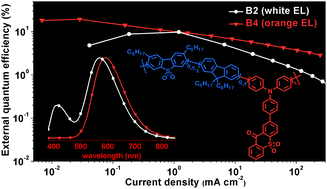Bright white electroluminescence from a single polymer containing a thermally activated delayed fluorescence unit and a solution-processed orange OLED approaching 20% external quantum efficiency†
Abstract
Developing a high-performance orange/red thermally activated delayed fluorescence (TADF) emitter, which is of great importance for white light emission and full-color displays, is still challenging due to the large non-radiative internal conversion rates governed by the energy-gap law in the purely organic emissive materials. In this study, a series of conjugated polymers with a backbone-donor/pendant-acceptor architecture was designed and synthesized, in which a twisted donor/acceptor structural unit was covalently bonded into the backbone via its donor fragment. The polymers excellently inherited the intrinsic features of the TADF small molecule used as a monomer in copolymerization. The non-doped organic light-emitting diodes (OLEDs) exhibited white emission, with CIE coordinates of (0.32, 0.31), by balancing the emission from the backbone and the TADF unit. Moreover, a near 10% external quantum efficiency (EQE) with warm white emission and an EQE of up to 19.4% with bright orange emission were achieved in the doped TADF polymer-based devices with controlled content of the TADF unit.



 Please wait while we load your content...
Please wait while we load your content...